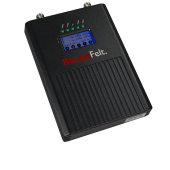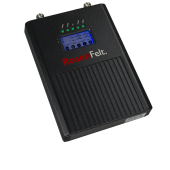
A common problem for many newly built offices is not being able to make calls. The cell phone signal does not penetrate through walls and windows, so calls drop out. Sometimes it is not possible to make calls at all, and one has to move close to a window to be able to make calls.
- Why is there no mobile coverage inside the new offices?
- How can I increase mobile coverage?
- What should I pay attention to when installing a GSM repeater?
- What else does a GSM repeater work for?
1. Why is there no mobile coverage inside the new offices?
Such situations often occur in newly constructed buildings. The mobile signal outside is very good, because there are more than enough transmission towers for cell phones. However, we see that the mobile signal inside is often weak. There are two main reasons for this problem...
Insulation too good
The first and biggest cause is too good insulation in new buildings. Nowadays, newly constructed buildings are increasingly insulated. Not only have regulations become stricter, but also the standard is becoming higher. After all, good insulation keeps heat inside the building, reducing energy costs.
Nowadays, thermopane windows are often made in three layers, so as to limit thermal bridges and increase the insulation value. The thicker the windows, the less signal gets in. We often see that calling at the window is more effective. It is also often possible to call when the windows are open, whereas if the windows are closed there is not enough signal, and calls are missed or interrupted.
This is not only very annoying (companies can lose assignments), but it can also be dangerous.
The height of the building
Not only the insulation, but also the height of the building (or rather the transmission tower) causes a weak mobile signal.
This problem often occurs in metropolitan areas. Transmitters on transmission towers are often placed on rooftops or in special transmission towers. When transmitters are placed on broadcast antennas, the transmitters often do not exceed 15 meters. When transmitters are on rooftops, frequencies have difficulty reaching all floors.
We often see that the signal in an office building on the lower floors is still good. The higher we go, the weaker the signal becomes. A transmitter on a broadcast tower is aligned so that the signal is transmitted horizontally in the environment. The signal does not reach the upper floors of tall office buildings, so the signal on the upper floors is often weak.
2. How can I increase mobile coverage?
What many people don't know is that cell phone range inside a building can be enhanced quite easily. With the help of a GSM repeater (also called a GSM amplifier) you can bring the signal from outside to inside. A GSM repeater works with an outdoor and indoor antenna. The outdoor antenna is placed outside, preferably as high as possible. The outdoor antenna receives the signal outside; the signal is received by the relay tower. The signal is routed to the repeater via a coaxial cable, which is connected indoors. One or more indoor antennas provide mobile coverage inside the building. Only the repeater is connected via an adapter; the antennas are connected via coaxial cable. A standard repeater set is supplied that includes all the necessary equipment. The more powerful the repeater, the more indoor antennas can be connected.
A GSM repeater receives one or more frequencies. It is therefore possible to reinforce multiple providers using a repeater.
3. What should I pay attention to when installing a GSM repeater?
In principle, installing a GSM repeater is quite simple, but there are a number of important points that need to be considered.
Make sure that the outdoor antenna is placed outside
At first glance an obvious thing, but it often happens that this is not the case. When the outdoor antenna is placed inside, it will receive little or no signal. After all, there is no signal inside. However, the outdoor antenna is often placed indoors, due to limited technical or aesthetic possibilities.
Do not place indoor antennas too close to a window
When an indoor antenna is placed near a window, the repeater tends to receive the signal from this indoor antenna. Especially when the outdoor antenna is placed near this window. When the outdoor antenna receives the signal from the indoor antenna, interference occurs, the repeater amplifies its own signal. The repeater sees this as a malfunction, causing it to shut down.
Then make sure that there is sufficient ground between the outdoor antenna and the indoor antenna, so that they cannot receive the signal from each other.
Do not use products other than those provided
It is recommended to use only the delivered products or otherwise the products on this site. It often happens, for example, that other coaxial cables, such as 75 Ohm coaxial cables, are used. These are coaxial cables used, among other things, for television and alarm systems. These cables have different attenuation, so they will not work in combination with a GSM repeater. A GSM repeater requires 50-ohm coaxial cables, which are characterized by low impedance (signal loss). Other connectors or antennas are also not recommended, as they often do not support the correct frequencies.
Ask the GSM REPEATER SHOP for advice in advance.
Not sure which repeater and accessories you need? Contact us for a customized consultation. Based on the address, we can see where the transmission towers are located and then determine the chances of success. Also, we can determine based on a floor plan how many indoor antennas are needed and where they should be placed. Finally, we would like to know how good the cell phone signal is outside, indicated in the number of reception bars on the cell phone. All in all, let's work out a recommendation so that you know what you need and how it should be mounted. Of course completely without obligation!

4. What else does a GSM repeater work for?
With the help of a GSM repeater you not only strengthen the range of mobile telephony within your building, you amplify a certain frequency, which is also used for other purposes. For example, mobile frequencies are also used for ATMs. Or again, when the mobile signal inside a restaurant is too weak, the card reader will not receive any signal.
GSM repeaters (4G repeaters) are also regularly used in conjunction with a 4G router. A 4G router receives the mobile signal (4G) and converts it into a WiFi network. When the router receives an insufficient 4G signal, only a weak WiFi network is created. A 4G repeater solves this. The outdoor antenna receives the 4G signal from the broadcast tower, the repeater amplifies this signal, and the indoor antenna provides coverage inside a building. Make sure that the indoor antenna is placed close to the 4G router. As a result, the 4G router will receive the 4G signal from the repeater instead of the broadcast tower.
In addition to our guaranteed support, try also taking a look here for help in choosing the repeater that's right for you 4G signal repeater: how to choose.

